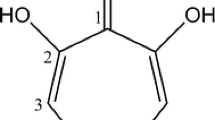Abstract
Changes in the isoprenoid quinone composition ofMicrococcus varians IAM 12146 in response to growth in different media were investigated. When the bacterium was growth in an ordinary complex medium, it produced menaquinones as the sole quinones, with a dihydrogenated menaquinone with seven isoprene units as the major component, at all growth stages. On the other hand, cells grown in a chemically defined medium containing glutamate and pyruvate as carbon sources produced both menaquinones and demethylmenaquinones. The major demethylmenaquinone homologs produced were the unsaturated and dihydrogenated types with seven isoprene units. The demethylmenaquinone/menaquinone ratio in cells varied during a batch growth in the chemically defined medium. The highest ratio was found in cells at the mid-exponential phase of growth.
Similar content being viewed by others
Literature Cited
Baum RH, Dolin MI (1965) Isolation of 2-solanesyl-1,4-naphthoquinone fromStreptococcus faecalis 10 C1. J Biol Chem 240:3425–3433
Bentley R, Maganathan R (1982) Biosynthesis of vitamin K (menaquinone) in bacteria. Microbiol Rev 46:241–280
Collins MD (1985) Analysis of isoprenoid quinones. In: Gottschalk G (ed) Methods in microbiology, vol 18. London: Academic Press, pp 329–366
Collins MD, Jones D (1979) The distribution of isoprenoid quinones in streptococci of serological groups D and N. J Gen Microbiol 114:27–33
Collins MD, Jones D (1981) Distribution of isoprenoid quinone structural types in bacteria and their taxonomic implications. Microbiol Rev 45:316–354
Hammond RK, White DC (1969) Formation of vitamin K2 isoprenologues byStaphylococcus aureus. J Bacteriol 100:573–578
Hiraishi A (1988) High-performance liquid chromatographic analysis of demethylmenaquinone and menaquinone mixtures from bacteria. J Appl Bacteriol 64:103–105
Hiraishi A, Kitamura H (1984) Differences in phototrophic growth on high phosphate concentrations amongRhodopseudomonas species. J Ferment Technol 62:293–296
Hiraishi A, Komagata K (1989) Effects of the growth medium composition on menaquinone homolog formation inMicrococcus luteus. J Gen Appl Microbiol 35:311–318
Hiraishi A, Hoshino Y, Kitamura H (1984) Isoprenoid quinone composition in the classification ofRhodospirillaceae. J Gen Appl Microbiol 30:197–210
Kroppenstedt RM, Mannheim W (1989) Lipoquinones in members of the familyPasteurellaceae. Int J Syst Bacteriol 39:304–308
Lester RL, White DC, Smith SL (1964) The 2-desmethyl vitamin K2's. A new group of naphthoquinones isolated fromHemophilus parainfluenzae. Biochemistry 3:949–954
Ogasawara-Fujita N, Sakaguchi K (1976) Classification of micrococci on the basis of deoxyribonucleic acid homology. J Gen Microbiol 94:97–106
Tamaoka J, Katayama-Fujimura Y, Kuraishi H (1983) Analysis of bacterial menaquinone mixtures by high performance liquid chromatography. J Appl Bacteriol 54:31–36
Unden G (1988) Differential roles for menaquinone and demthylmenaquinone in anaerobic electron transport ofE. coli and theirfnr-independent expression. Arch Microbiol 150:499–503
Whistance GR, Threlfall DR (1968) Effect of anaerobiosis on the concentrations of demethylmenaquinone, menaquinone, and ubiquinone inEscherichia freundii, Proteus mirabilis, andAeromonas punctata. Biochem J 108:505–507
Whistance GR, Dillon JF, Threlfall DR (1969) The nature, intergeneric distribution and biosynthesis of isoprenoid quinones and phenols in Gram-negative bacteria. Biochem J 111:461–472
Yamada Y, Inouye G, Tahara Y, Kondo K (1976) The menaquinone system in the classification of aerobic Gram-positive cocci in the generaMicrococcus, Staphylococcus, Planococcus, andSporosarcina. J Gen Appl Microbiol 22:227–236
Author information
Authors and Affiliations
Rights and permissions
About this article
Cite this article
Hiraishi, A., Sugiyama, J. & Komagata, K. Simultaneous formation of menaquinones and demethylmenaquinones byMicrococcus varians IAM 12146 depending on cell growth media. Current Microbiology 22, 53–58 (1991). https://doi.org/10.1007/BF02106213
Issue Date:
DOI: https://doi.org/10.1007/BF02106213




